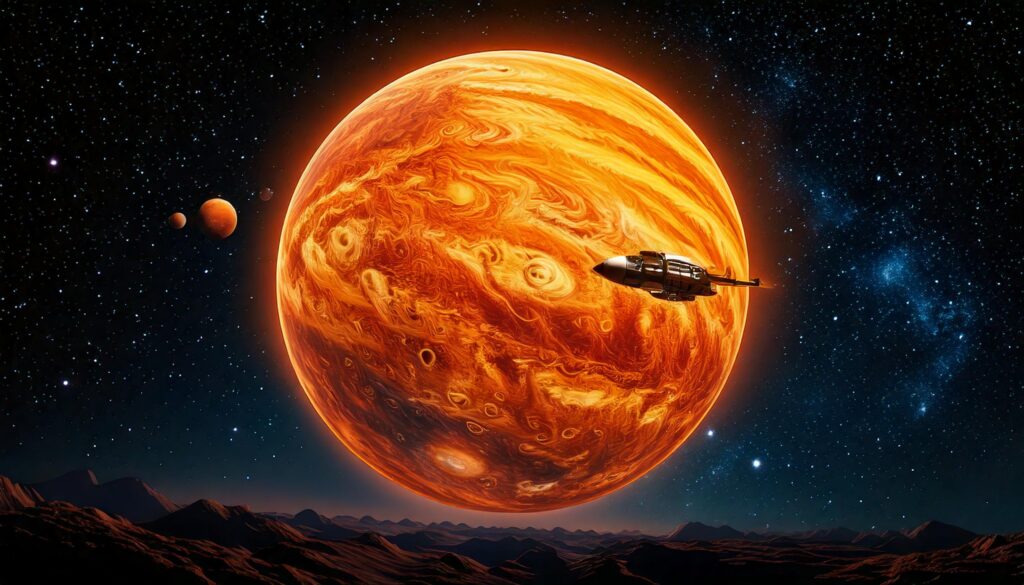
With the “Venus Exploration with AR & AI” project, students can dive into the mysteries of one of Earth’s closest planetary neighbors using accessible, hands-on technology. Using just a computer with a webcam and connecting it to a projector, TV, or smart board, teachers can guide students through an immersive learning experience focused on Venus’s unique characteristics. This free, interactive resource walks students through Venus’s similarities and differences with Earth, its volcanic surface, extreme greenhouse effect, and unusual rotation, turning complex planetary science concepts into engaging lessons. It is free for teachers.
Each phase of the project integrates Augmented Reality and AI prompts to create a vivid exploration of Venus that aligns with NGSS standards and sparks curiosity. Students will discover why Venus is hotter than Mercury, observe simulated volcanic activity, and understand the greenhouse effect’s impact on its thick atmosphere. This guide offers a step-by-step breakdown of each stage, providing teachers with classroom activities, discussion ideas, and formative assessments designed to make learning about Venus both interactive and meaningful. Download the project today to bring Venus into your classroom and inspire a deeper understanding of planetary science.
Instruction Guide
Introduction to the Project:
- Stage 1: Meet Earth’s Sister Planet – Introduce Venus and highlight its similarities and differences with Earth, particularly in size, mass, and atmosphere.
- Stage 2: Venus’s Volcanic Surface – Explore Venus’s rocky surface and volcanic activity, with students simulating eruptions and capturing images.
- Stage 3: The Hottest Planet in the Solar System – Discuss why Venus is hotter than Mercury, focusing on its thick atmosphere and the greenhouse effect.
- Stage 4: The Greenhouse Effect and Carbon Dioxide Atmosphere – Explain how Venus’s carbon dioxide-rich atmosphere causes the greenhouse effect, using comparisons to Earth.
- Stage 5: Backward-Spinning Venus – Explore Venus’s unique rotation, where the Sun rises in the west, introducing concepts of planetary rotations and orientations.
Each stage involves narration and interactive prompts that guide students through the exploration, encouraging curiosity, discussion, and hands-on learning about Venus.
Learning Objectives and Outcomes
Learning Objectives with NGSS Standards Alignment:
- Compare Venus and Earth in Terms of Size, Mass, and Atmosphere
- Objective: Students will understand Venus’s position as Earth’s “twin” planet in size and mass while contrasting their atmospheric and environmental conditions.
- NGSS Alignment: ESS1.B: Earth and the Solar System – Understand the physical characteristics of Venus in comparison to Earth.
- NGSS Code: 5-ESS1-1 – Recognize and describe the physical characteristics of planets, such as mass, size, and atmosphere.
- Explore Venus’s Volcanic Activity and Surface Features
- Objective: Students will observe Venus’s rocky surface, exploring its volcanic structures and understanding how surface processes differ from Earth’s.
- NGSS Alignment: ESS2.B: Plate Tectonics and Large-Scale System Interactions – Introduces surface activity, such as volcanic eruptions, to understand planetary geology.
- NGSS Code: 5-ESS2-1 – Develop a model to describe Earth’s systems’ interactions, comparing them to volcanic activity on Venus.
- Understand Why Venus is the Hottest Planet Despite Not Being Closest to the Sun
- Objective: Students will learn that Venus’s thick atmosphere traps heat effectively, making it hotter than Mercury.
- NGSS Alignment: PS3.B: Conservation of Energy and Energy Transfer – Examines how Venus’s atmosphere traps solar energy, creating an intense greenhouse effect.
- NGSS Code: 5-PS3-1 – Use models to describe how energy from the Sun is transferred and transformed in planetary atmospheres.
- Learn How Venus’s Atmosphere Causes the Greenhouse Effect
- Objective: Students will examine Venus’s carbon dioxide-dense atmosphere, learning how it traps heat and comparing it to Earth’s atmosphere.
- NGSS Alignment: ESS3.C: Human Impacts on Earth Systems – By understanding Venus’s greenhouse effect, students gain insight into how atmospheric gases affect planetary temperatures.
- NGSS Code: 5-ESS3-1 – Obtain and combine information about how communities use science to protect Earth’s resources, drawing parallels to Earth’s carbon dioxide levels.
- Discover Venus’s Unique Rotation and How it Differs from Other Planets
- Objective: Students will explore how Venus’s retrograde rotation causes the Sun to rise in the west and set in the east, unlike most planets.
- NGSS Alignment: ESS1.B: Earth and the Solar System – Helps students understand planetary rotations and how they differ across planets.
- NGSS Code: 5-ESS1-2 – Represent data to show patterns of daily changes in shadows, day and night, and seasonal star appearances.
Learning Outcomes:
- Outcome 1: Students can summarize Venus’s characteristics, including its extreme heat, volcanic surface, and atmosphere.
- Outcome 2: Students can discuss and compare Venus and Earth, particularly in terms of atmospheric differences and surface conditions.
- Outcome 3: Students use scientific vocabulary aligned with NGSS and Common Core standards to describe Venus’s environmental features, greenhouse effect, and retrograde rotation.
Classroom Activity Design
Pre-AR Project Activities (Warm-Up & Background Building)
- Planet Comparison Warm-Up
- Objective: Familiarize students with the similarities and differences between Venus and Earth.
- Activity: Students use a visual chart to compare and contrast Earth and Venus by matching characteristics like “life,” “volcanoes,” and “extreme heat.”
- Outcome: Builds background knowledge of Venus’s features compared to Earth, preparing students for exploration.
- Greenhouse Effect Basics Discussion
- Objective: Introduce students to the concept of the greenhouse effect.
- Activity: Use a simple demonstration (e.g., covering a small object with a clear container in sunlight) to show how heat can be trapped. Ask, “How would it feel if the Sun’s heat couldn’t escape?”
- Outcome: Prepares students to understand Venus’s extreme heat caused by a dense atmosphere trapping solar energy.
Post-AR Project Activities (Reinforcement & Hands-On Learning)
- Venus Reflection Journal
- Objective: Reinforce learning by having students summarize key points about Venus’s atmosphere, rotation, and volcanic activity.
- Activity: Students write a short entry or draw about what makes Venus unique.
- Example Prompts:
- “Why is Venus hotter than Mercury, even though it’s farther from the Sun?”
- “Describe what Venus’s atmosphere is like.”
- Outcome: Encourages reflection and reinforces comprehension of Venus’s environment.
- Volcano Eruption Simulation (Hands-On)
- Objective: Help students visualize volcanic activity on Venus.
- Activity: Using baking soda and vinegar, simulate a small “eruption” in a tray. Discuss how Venus has many volcanoes and may still have some active ones.
- Outcome: Provides a tangible demonstration of volcanic activity, linking to Venus’s surface features.
- Backward Sunrise Simulation
- Objective: Demonstrate Venus’s retrograde rotation and unique sunrise direction.
- Activity: Use a compass or directional cues in the classroom to show students where the Sun rises and sets on Earth versus Venus.
- Outcome: Reinforces understanding of Venus’s unique rotation, allowing students to visualize its backward spin.
Classroom Management Tips
- Clear Viewing: Ensure all students can see the AR project screen or display to stay engaged during the exploration.
- Rotate Participation: Rotate students so each has the opportunity to engage with the interactive portions and share responses.
- Pre-Prepared Responses: Guide students in preparing answers for AI conversations, especially for more complex topics like the greenhouse effect, to build confidence.
- Positive Reinforcement: Praise students’ contributions and encourage active participation, supporting a positive learning environment.
- Turn-Taking: Monitor participation to ensure all students have a turn, especially during interactive activities like simulated eruptions.
Formative Assessments
- Venus and Earth Comparison Activity
- What It Is: A simple activity where students match characteristics to either Venus or Earth, such as “poisonous atmosphere” or “life.”
- Purpose: Reinforces understanding of Venus’s unique features by comparing them to Earth’s.
- Reflection Journal Entry
- What It Is: After the AR experience, students write or draw about Venus’s rotation, greenhouse effect, or volcanic surface.
- Example Prompts:
- “What causes Venus to be the hottest planet?”
- “Why does Venus have such a thick atmosphere?”
- Purpose: Allows students to express their understanding and reflect on new concepts.
- Greenhouse Effect Demonstration
- What It Is: After explaining the greenhouse effect, ask students to describe or draw how Venus’s atmosphere traps heat.
- Purpose: Reinforces understanding of how Venus’s dense atmosphere affects temperature.
Cross-Subject Integration Suggestions
- Math: Calculate the relative distances of Venus and Earth from the Sun or explore the extreme temperatures on Venus versus Earth.
- Art: Draw Venus’s landscape, including volcanoes, thick clouds, and its “backward” sunrise.
- Language Arts: Write a paragraph comparing Venus and Earth, using vocabulary like “greenhouse effect,” “rotation,” and “volcano.”
- Social Studies: Discuss historical space missions to Venus, like the Soviet Venera probes, to provide context on exploration efforts.




Recent Comments